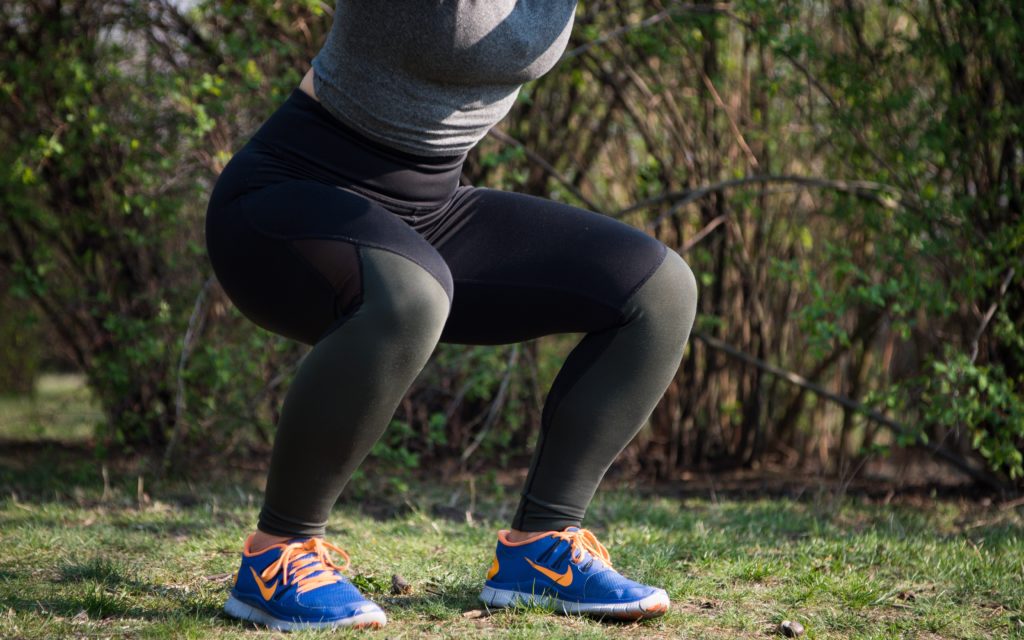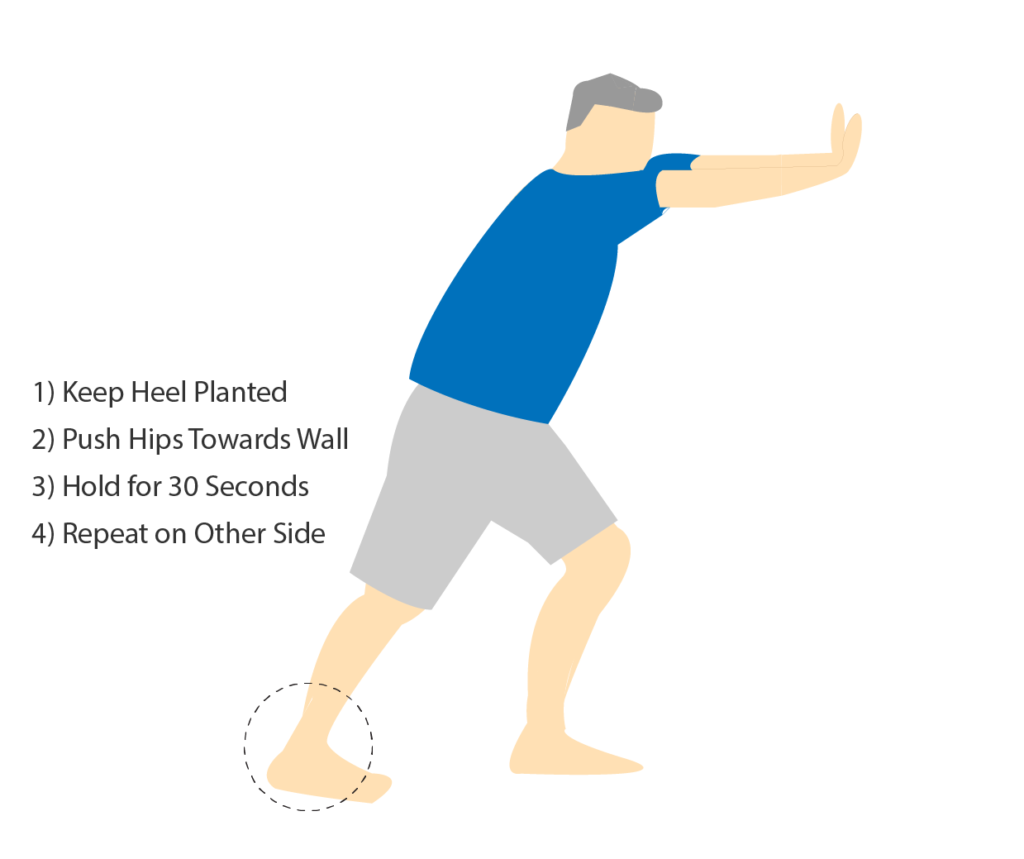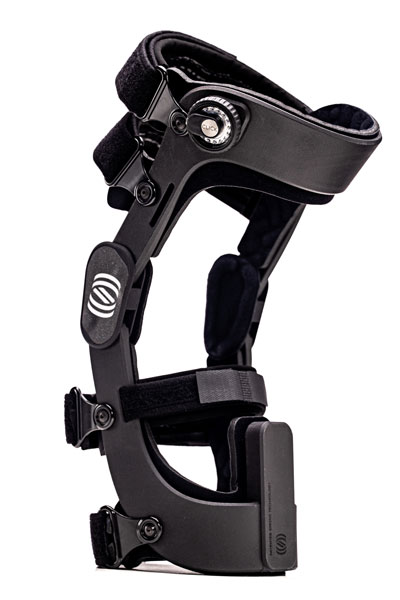Knee Pain When Squatting? 3 Common Fixes.

Knee pain when squatting has many possible causes. Both joint inflexibility and poor muscle stability are usually contributing factors. You don’t have to be a yogi, but keeping your joints limber may help move stress away from your knees. Fortunately, it is possible to dramatically improve joint mobility in just one short stretching session. The bad news is that these mobility changes will disappear quickly if not maintained through consistent exercise. Getting into a proper routine is essential. Below are the key areas to focus on and simple exercises to try at home!
Increase your Ankle Mobility
Ankle mobility is a massive factor affecting squatting mechanics. If you are lacking in this department, the deeper you squat down the more trouble you will be in. The main consequence will be your knees caving inwards and heels lifting off the ground. Both of these movement patterns increase pressure on the knees and are associated with knee pain when squatting. Further, these movement dysfunctions along with ankle stiffness are a factor in several of the most common conditions causing knee pain.
- A lack of ankle mobility is a risk factor for patellar tendonitis. Athletes who have limited ankle flexibility are worse at absorbing impact during jump landings.1 This leads to more stress on the knee joint as time goes on.
- Those with knee arthritis tend to have flatter feet and squat with their feet turned out. Both of these undesirable foot positions are commonly caused by poor ankle range of motion.2 Patients with patellar (kneecap) arthritis exhibit 20% less ankle mobility than healthy individuals.3 Furthermore, approximately 73% of knee osteoarthritis patients have signs of arthritis behind their kneecap.4 Knee pain when squatting is one of the most common complaints associated with knee arthritis. Loosening up the ankles could help improve knee function thereby reducing arthritis-related knee pain.
- Patellofemoral Pain Syndrome (PFPS) is one of the most common causes of knee pain across all ages. Ankle mobility is considered to be a key factor in assessing the underly cause(s) of this condition.5
Hopefully, you’re convinced that supple ankle joints are important, now let’s figure out if yours are stiff or not! Try the test below. It’s fast and simple – only requiring a ruler and a wall.
Home Ankle Mobility Test 6
- Place a ruler on the floor at a right angle to a wall. The zero point on the ruler should be closest to the wall.
- Make a mark 9 centimeters (3.5 inches) away from the wall, and line up your big toe with the mark.
- Step backward into a lunge position with your back knee on the floor (use a cushion if your knee is sensitive to pressure).
- Keeping your big toe behind the mark, try to touch your knee to the wall. Do not lift your heel or let your foot collapse inwards. Keep the knee moving forward in line with your big toe.
If you cannot touch the wall with your knee it’s possible that your calf muscles are tight causing your ankle joint to be stiffer than it should be. If this is the case try doing the stretch below frequently throughout the day and then retest!

Increase your Hip Strength
If your knees were the horse, your hips would be the chariot. The muscles around your hips exert a major influence on how your knees move, particularly during the squat. Weakness and/or sub-optimal function of hip musculature plays a role in almost all common knee conditions: knee osteoarthritis7, PFPS8, ACL injuries9, and ITBS10.
The glutes help push your knees out (external rotation) as you squat down. If they are weak, or you do not coordinate them properly, your knees will tend to cave in (Knee Valgus). This places abnormal stress on the knee cap, meniscus, ACL, and MCL. Keeping your glutes engaged can help with your knee alignment by forcing your knees to line up with your toes as you descend deeper into the squat position. Try adding the hip exercises below into your exercise routine to increase the strength of your hips and glutes:
Wear a Supportive Brace or Garment
If you are on the go and don’t have time to exercise, a knee sleeve or brace could be a better solution to help decrease your knee pain when squatting. Both anecdotal evidence and scientific research suggest that knee sleeves can reduce pain.11 They provide compression around your joint. This can help keep swelling and inflammation under control.

Knee braces go a few steps farther by offloading and stabilizing the knee joint. Most traditional hard shell knee braces will help keep your knee aligned laterally. Offloader knee braces are a fairly new innovation that can offload parts of, or your entire knee joint. These braces are favored by individuals suffering from knee arthritis. Offloader braces with tri-compartment offloading technology are capable of actively reducing pressure and knee pain when squatting. Learn more about this technology here!
Is you’re unsure which type of brace will meet your needs, take a look at our comparison of a Donjoy knee brace with a Spring Loaded knee brace here. The Donjoy knee brace is one of many traditional offloaders on the market, while a Spring Loaded knee brace is a tri-compartment offloader.
Additional Reading
- Complete Guide to Knee Pain
- It’s Not Your Knee It’s Your Hip
- Top Five Offloader Knee Braces
- Donjoy Knee Brace vs a Spring Loaded Knee Brace
References
- Malliaras, P., Cook, J. L., & Kent, P. (2006). Reduced ankle dorsiflexion range may increase the risk of patellar tendon injury among volleyball players. Journal of science and medicine in sport, 9(4), 304-309.
- Reilly, K., Barker, K., Shamley, D., Newman, M., Oskrochi, G. R., & Sandall, S. (2009). The role of foot and ankle assessment of patients with lower limb osteoarthritis. Physiotherapy, 95(3), 164-169.
- Wyndow, N., Collins, N. J., Vicenzino, B., Tucker, K., & Crossley, K. M. (2018). Foot and ankle characteristics and dynamic knee valgus in individuals with patellofemoral osteoarthritis. Journal of foot and ankle research, 11(1), 65.
- Mohammed, K.S. Al-Obaedi, O. Shah, M. (2018). Prevalence of Compartmental Osteoarthritis of the Knee in an Adult Patient Population: A Retrospective Observational Study. EC Orthopaedics
- Halabchi, F., Abolhasani, M., Mirshahi, M., & Alizadeh, Z. (2017). Patellofemoral pain in athletes: clinical perspectives. Open access journal of sports medicine, 8, 189.
- Bennell, K., Talbot, R., Wajswelner, H., Techovanich, W., Kelly, D., & Hall, A. J. (1998). Intra-rater and inter-rater reliability of a weight-bearing lunge measure of ankle dorsiflexion. Australian Journal of physiotherapy, 44(3), 175-180.
- Neelapala, Y. R., Bhagat, M., & Shah, P. (2018). Hip Muscle Strengthening for Knee Osteoarthritis: A Systematic Review of Literature. Journal of geriatric physical therapy (2001).
- Santos, T. R., Oliveira, B. A., Ocarino, J. M., Holt, K. G., & Fonseca, S. T. (2015). Effectiveness of hip muscle strengthening in patellofemoral pain syndrome patients: a systematic review. Brazilian journal of physical therapy, 19(3), 167-176.
- Khayambashi, K., Ghoddosi, N., Straub, R. K., & Powers, C. M. (2016). Hip muscle strength predicts noncontact anterior cruciate ligament injury in male and female athletes: a prospective study. The American journal of sports medicine, 44(2), 355-361.
- Mucha, M. D., Caldwell, W., Schlueter, E. L., Walters, C., & Hassen, A. (2017). Hip abductor strength and lower extremity running related injury in distance runners: a systematic review. Journal of science and medicine in sport, 20(4), 349-355.
- Mazzuca, S. A., Page, M. C., Meldrum, R. D., Brandt, K. D., & Petty‐Saphon, S. (2004). Pilot study of the effects of a heat‐retaining knee sleeve on joint pain, stiffness, and function in patients with knee osteoarthritis. Arthritis Care & Research: Official Journal of the American College of Rheumatology, 51(5), 716-721
Frequently Asked Questions
Common contributors to knee pain while squatting are muscle weakness, joint instability, and inflexibility. These issues can be addressed with properly designed exercise prescription.
Start by ensuring you have proper squatting technique. Generally, the further the knees go over the toes the more pressure is placed on the knee. Trying reaching back with your hits, or squatting back into a chair or box. Ensure your bodyweight stays on your heels throughout the entire movement. Lastly, your knees should stay in line with your toes during the descent.
The most important joints to mobilize are your ankles, hips and upper back. Start by stretching your upper and lower calf muscles. Then, stretch your glutes and hip-flexors. Lastly, mobilize your thoracic spine. Ensure you hold each stretch for at least~30 seconds.
Knee supports range from rigid frame braces to soft neoprene sleeves. Anecdotally, many find that the compression and extra warmth provided by sleeves causes their knees to feel less stiff. The only type of brace that actually reduces the impact on the knee joint itself, is a tri-compartment offloader knee brace. These devices are ideal for individuals with arthritis and meniscal injuries.
Personal Trainers and/or Physical Therapists can assess your technique and provide you with a custom exercise program to help improve your knee function during activities requiring deep joint flexion.